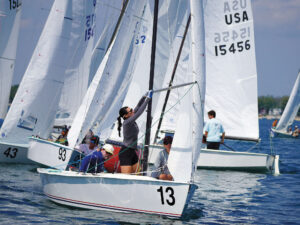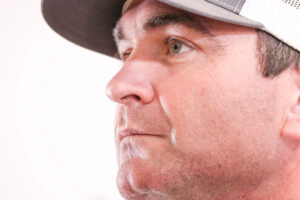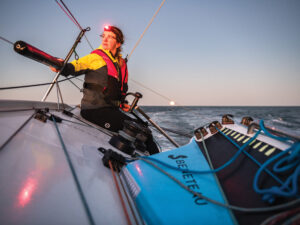
PleasurePain
Mackinac Island, which lies at the top of lakes Huron and Michigan, is a destination worth getting to. It’s a bit different from other resorts, in that no motorized vehicles, save fire and rescue vehicles, are allowed. Horse-drawn carriages and bicycles are the main modes of transportation, and life slows down a bit for those who vacation here. For a few days each July, however, the pace picks up a bit, as a couple thousand thirsty racing sailors arrive en masse and change the mood on this sleepy island. Two distance races, one starting from Port Huron, Michigan, the other from Chicago, Illinois, end in the waters off Mackinac, and draw hundreds of entries. The 2,000 or so crew on these boats work hard to get here, and when they do, it’s all about partying. This year, I wanted to see what it was like to race the Bacardi Bayview Mackinac Race, and was lucky enough to join the crew of Fran and Jerry Anderson’s Beneteau First 40.7 Bushwacker, for the race. We sailed the 235-nautical mile Southampton Course, which features one turning mark, named NGS, off Canada, about 99 miles up the course, which boats have to round before pointing their bows to Mackinac. At a weather briefing before the start of the race, we were all shown an image on the large screen the forecaster was using to illustrate how he thought the weather gods would treat us. On one side, a satellite shot of a hurricane, on the other, a parking lot crowded with cars. The thrust of his graphic was that we wouldn’t see either extreme during the course of the race. He was wrong. The enthusiasm level for the Bacardi Bayview Mac is high, and unlike other distance races held in the United States and Canada, it goes beyond the sailors themselves. The first inkling I got of this dynamic happened when I arrived in Port Huron last Friday afternoon, the day before the race started. As photographer Walter Cooper and I drove into town, we started seeing signs one would associate more with NASCAR racing than a yacht race, like “Welcome Race Fans,” banners with beer logos on them. The feeling intensified as we got closer to Port Huron YC. The Black River, which flows into Lake Huron, was packed with boats getting ready for the race. Radio and TV stations had booths and vehicles stationed at vantage points near, or on, the docks, and packed crowds of non-sailors strolled the docks, looking at the boats. On race day, the enthusiasm reached a fever pitch, and hundreds of people lined both sides of the river. Seated in lawn chairs, standing on the porches of bars and restaurants, and riding in powerboats, the crowd was waiting not for the race to start, because that was happening out on the lake, but just to see the boats head out to the racecourse. As we passed by the packed Port Huron YC, situated at the mouth of the Black River, we were even serenaded by a band of kilt-wearing drummers and bagpipers. As we hugged the Canadian side of the St. Claire River on our way to Lake Huron, we were cheered on by hundreds more spectators. I’ve done a lot of distance races, but I’ve never seen quite the type of send-off we experienced before the start of the Bayview-Mac.Out on Lake Huron, more spectators bobbed around on boats in designated viewing areas, kept in check by Coast Guard Auxiliary boats and boundaries marked by orange buoys. We were the fifth class to start, and leaving the spectators behind, we began our 44-hour jaunt up the length of Lake Huron. We got to the NGS buoy about 15 hours into the race, and rounded in good company. Jan and Meade Gougeon’s trimaran Addagio rounded about 30 minutes before us, the GL 70 Stripes about 10 minutes before. We were the first in our IRC E class, closely followed by another 40.7, Engager. We were feeling pretty good about where we were in relation to the fleet and our class. The weather forecaster who spoke at the pre-race briefing Saturday morning had said we’d see no extremes for this year’s Bayview-Mac. He was wrong. During our race we saw winds of 30 knots, no wind at all, and everything in between. We subjected our bow team to more sail changes in two days then I’d seen in the entire 635-mile Bermuda Race the month before. They handled it all with aplomb, even during one exciting period when the wind clocked through every direction in about half an hour, went from 5 knots to 25, and back down to five again. We reached, ran, went hard on the wind, and saw every sail in the inventory except the No. 4 jib and the ounce-and-a-half asymmetric spinnaker. There’s one feature of racing on the Great Lakes that I could do without, the flies. Anyone who’s ever raced in the Lakes will tell stories about how numerous they are, and how much (and how hard) they bite. Everything you’ve ever heard is true. They look innocent enough, bearing an uncanny resemblance to an ordinary housefly, but they bite, even through light shirts and socks. During one relatively light-air period on Sunday I steered the boat with one hand on the wheel, while the other wielded a flyswatter. Down below, the off watch wrapped themselves from head-to-toe in sheets like mummies, hoping to escape the worst of the flies. On a happy note, we saw no Mayflies, which swarm from the lakes in the billions for a few days each year and have been known to cover boats in a squirming, smelly carpet of thrashing wings and bodies. Earlier this year, one bloom of Mayflies had been numerous enough to be picked up by weather radar from a local TV station.We came roaring towards the Straits of Mackinac with good breeze Sunday, but by sunset the wind had dropped. The leftover chop from the day’s stronger breezes made steering hard, but it got worse that night when the wind dropped down to less than two knots. At about 80 miles from the finish line, our GPS estimated we’d cross the line some four days later. By sunrise Monday, however, we’d managed to wriggle our way from puff to puff and drew within 30 miles of Mackinac, and the wind piped back up to the mid 20s.As we approached the Straits, we began to see more and more boats, including the ones that had sailed the shorter Shore Course. They were all tight reaching their way to the finish, with everyone on the rail and hiking hard. As we came around a small point of land, we could see Mackinac Island’s bluffs and the lighthouse that marks the southern end of the island. We finished just shy of 9 a.m. (24 hours and 20 minutes behind the line honors boat, the MaxZ 86 Windquest) and headed for the docks, packed with boats that had already finished, two of which were in our class and owed us time, one of which we owed time to. When we were tied up on the outside of a five-boat raft, we were in second. By the time we had our first beer, we were in third, then fourth, as smaller boats in our class came rumbling in. By the time I’d checked into my hotel and taken a shower, we had dropped down to sixth in our nine-boat class. The disappointment of our finish began to fade by the time our crew rendezvoused at one of the icons of any Mac race, the Pink Pony bar. By two o’clock in the afternoon, it seemed as if every single sailor in the fleet had packed into the Pink Pony, and the scene was a chaotic mishmash of shouting, gesticulating, and tall tales. Windquest, owned by Doug DeVos, finished in 24 hours, 17 minutes, 38 seconds, 1h:12m faster than the record set last year by Bill Alcott’s Equation the year before. Alcott and his team can take some consolation in losing their record, however, as they corrected out against everyone on the Southampton course and took first overall in the division. The winner of the 240-mile Shore Course was the 39-year old Bristol 27 Sea Wise, owned by Charlie Weiss, which finished Monday morning just after 10:00 a.m.I may never get to be an Old Goat (a sailor who’s competed in 25 Mackinac races), but I will come back and do this race again. It’s a challenging race, and there’s great competition to be had. Sailing with and against Great Lakes racers and getting to Mackinac Island is well worth any amount of pain inflicted by ravenous bugs or fluky breezes.









